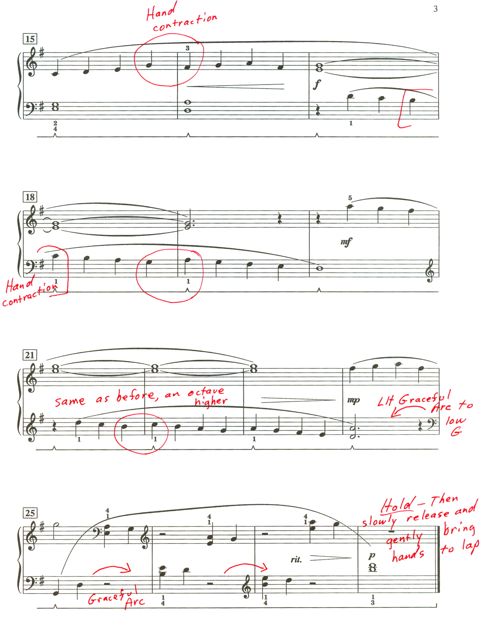Mr. A Presents "First Lyric Pieces"

Hear Mr. Alexander perform "Falling Leaves" in addition to two other selections from this collection on the "compositions" link above.This has always been one of my favorite collections. One of the mostsatisfying aspects of teaching piano is observing the late elementarylevel student become a musical artist, capable of expressing many moodsand styles through the performance of interesting and musical pianocompositions. I wrote this set of pieces to help inspire and enable thelate elementary student (at any age!) to perform in a lyrical andromantic manner, with the hope that such pieces will help them tounderstand and perform those gems of the Romantic period even better!You will discover that each piece in this collection has it's ownunique pedagogical challenges, and that they present some of the exactsame demands, at the late elementary level, as well-known Romanticmasterpieces. "Falling Leaves", which is the first piece in thecollection, is an excellent piece for learning how to use rubato,syncopated pedal technique, and creating a beautiful legato line.Other pieces in this collection include: "Ariana", "Arioso in C", "Cello Song", "Moonshadows", "Snowscape", and "Soul Mates".The "Mr. A Presents" series also includes two other collections at this same level: "First Showstoppers" and "First Ragtime Pieces"

Adults and children alike respond well to visual imagery, and this piece lends itself beautifully to such a concept. Achieving a natural sense of rubato is essential to an artistic performance of this piece. Initially, I would want the student to have a solid sense of rhythm and steadiness of pulse. But then, as soon as this is achieved, ask the student to imagine leaves falling from a tree on a beautiful autumn day. A slight wind will caress those leaves as they gently twist and turn on their way to the ground. They certainly don't just fall straight to the ground as if attached to a "weight" as they leave the branch! Those quarter notes in the RH are the leaves, and they need a delicate amount of rubato and sense of "movement" throughout each phrase. Ask the student to discover the "heart" of each phrase, and focus the movement as well as dynamic energy towards this "heart". I have marked this in several places throughout the score. Pedaling can also be an issue with some students who might not understand "legato pedal" technique. (another term for this is "syncopated pedal" technique). If so, this is a perfect piece for helping the student achieve a legato connection on each pedal change. Pedaling is a rhythmical issue-- have the student practice the LH alone, and count out loud while playing. Go "up" on beat one, and "down" on beat two, very consistently throughout. Once the legato pedal is learned, then ask the student to change this rhythmic pedaling to an eighth note pattern and go "down" on the "and of one" instead of on beat two. CLICK ON THE SCORE TO ENLARGE.

You will notice that I have circled the quarter rests in both hands at the end of ms. 4, 12, and 14. In the romantic style, when a composer indicates a rest in BOTH hands at the end of a measure, it is a clear indication that the performer should "breathe" slightly going over the barline-- a little "red flag" to simply encourage the pianist to not rush over the barline. Allow the pedal to sustain the sound, but simply elongate ever so slightly the "and" of beat 4. In addition, take a little time going into ms. 11, as that beautiful surprise harmony on beat one should be played very expressively and a little time here makes this so much more "delicious" to the listener's ear!

On page 2 of this piece there are several examples of hand contraction, the first being in the RH going into ms. 16. Students might want to isolate this and do "spot practice" until the contraction is comfortable and feels easy in the hand. Then in the following measures, the LH has the same type of pattern in those descending quarter notes. This descending line gradually gets softer, and at the end of ms. 24, have the student gracefully arc the left arm to that low G, and then use the same graceful arcs throughout the last line as both hands move up the keyboard. Be sure to follow the pedal suggestion on the last four bars-- ONE pedal and allow those beautiful autumn colors to blend together. Have your student hold both hands in position in that last measure and give full value to the whole note before gently and gracefully releasing the arms with the pedal and then bring the arms slowly to the lap. Simple pieces like this are magical for helping students understand the style of romantic repertoire. Later on, when they work on their first waltz or mazurka by Chopin, they will discover these same exact compositional elements in the music by these Romantic master composers and will consequently play them with much greater understanding and overall musicianship.




